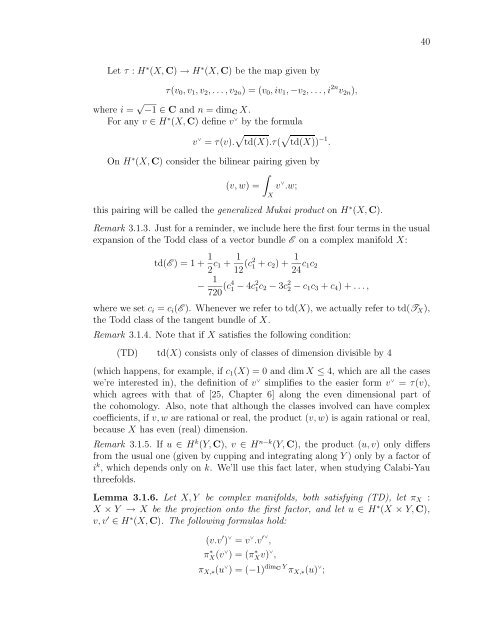derived categories of twisted sheaves on calabi-yau manifolds
derived categories of twisted sheaves on calabi-yau manifolds
derived categories of twisted sheaves on calabi-yau manifolds
Create successful ePaper yourself
Turn your PDF publications into a flip-book with our unique Google optimized e-Paper software.
Let τ : H ∗ (X, C) → H ∗ (X, C) be the map given by<br />
τ(v0, v1, v2, . . . , v2n) = (v0, iv1, −v2, . . . , i 2n v2n),<br />
where i = √ −1 ∈ C and n = dimC X.<br />
For any v ∈ H ∗ (X, C) define v ∨ by the formula<br />
v ∨ = τ(v). td(X).τ( td(X)) −1 .<br />
On H∗ (X, C) c<strong>on</strong>sider the bilinear pairing given by<br />
<br />
(v, w) = v ∨ .w;<br />
this pairing will be called the generalized Mukai product <strong>on</strong> H ∗ (X, C).<br />
Remark 3.1.3. Just for a reminder, we include here the first four terms in the usual<br />
expansi<strong>on</strong> <str<strong>on</strong>g>of</str<strong>on</strong>g> the Todd class <str<strong>on</strong>g>of</str<strong>on</strong>g> a vector bundle E <strong>on</strong> a complex manifold X:<br />
td(E ) = 1 + 1<br />
2 c1 + 1<br />
12 (c2 1 + c2) + 1<br />
24 c1c2<br />
− 1<br />
720 (c4 1 − 4c 2 1c2 − 3c 2 2 − c1c3 + c4) + . . . ,<br />
where we set ci = ci(E ). Whenever we refer to td(X), we actually refer to td(TX),<br />
the Todd class <str<strong>on</strong>g>of</str<strong>on</strong>g> the tangent bundle <str<strong>on</strong>g>of</str<strong>on</strong>g> X.<br />
Remark 3.1.4. Note that if X satisfies the following c<strong>on</strong>diti<strong>on</strong>:<br />
(TD) td(X) c<strong>on</strong>sists <strong>on</strong>ly <str<strong>on</strong>g>of</str<strong>on</strong>g> classes <str<strong>on</strong>g>of</str<strong>on</strong>g> dimensi<strong>on</strong> divisible by 4<br />
(which happens, for example, if c1(X) = 0 and dim X ≤ 4, which are all the cases<br />
we’re interested in), the definiti<strong>on</strong> <str<strong>on</strong>g>of</str<strong>on</strong>g> v ∨ simplifies to the easier form v ∨ = τ(v),<br />
which agrees with that <str<strong>on</strong>g>of</str<strong>on</strong>g> [25, Chapter 6] al<strong>on</strong>g the even dimensi<strong>on</strong>al part <str<strong>on</strong>g>of</str<strong>on</strong>g><br />
the cohomology. Also, note that although the classes involved can have complex<br />
coefficients, if v, w are rati<strong>on</strong>al or real, the product (v, w) is again rati<strong>on</strong>al or real,<br />
because X has even (real) dimensi<strong>on</strong>.<br />
Remark 3.1.5. If u ∈ H k (Y, C), v ∈ H n−k (Y, C), the product (u, v) <strong>on</strong>ly differs<br />
from the usual <strong>on</strong>e (given by cupping and integrating al<strong>on</strong>g Y ) <strong>on</strong>ly by a factor <str<strong>on</strong>g>of</str<strong>on</strong>g><br />
i k , which depends <strong>on</strong>ly <strong>on</strong> k. We’ll use this fact later, when studying Calabi-Yau<br />
threefolds.<br />
Lemma 3.1.6. Let X, Y be complex <strong>manifolds</strong>, both satisfying (TD), let πX :<br />
X × Y → X be the projecti<strong>on</strong> <strong>on</strong>to the first factor, and let u ∈ H ∗ (X × Y, C),<br />
v, v ′ ∈ H ∗ (X, C). The following formulas hold:<br />
X<br />
(v.v ′ ) ∨ = v ∨ .v ′∨<br />
,<br />
π ∗ X(v ∨ ) = (π ∗ Xv) ∨ ,<br />
πX,∗(u ∨ ) = (−1) dimC Y πX,∗(u) ∨ ;<br />
40
















